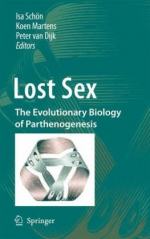|
This section contains 806 words (approx. 3 pages at 300 words per page) |

|
Parthenogenesis is a type of asexual reproduction in which offspring (progeny) arise from unfertilized eggs. The phenomenon is known among many invertebrate and vertebrate groups, including some species of nematodes, gastropods, crustaceans, insects (especially honey bees and wasps), fishes, amphibians and reptiles. Few species reproduce solely by parthenogenesis and it is more common that episodes of parthenogenesis alternate with periods of sexual reproduction. Parthenogenesis may occur for several generations and then be followed at some point by sexual reproduction. During the sexual period males develop, produce sperm, and mate with females to fertilize their eggs. In some species, parthenogenesis actually appears to be an adaptation for survival in times of stress or serious population decline.
In situations where unfertilized eggs usually perish and only occasionally develop by parthenogenesis, the condition is known as exceptional parthenogenesis, while in those species where unfertilized eggs regularly develop to produce progeny, the...
|
This section contains 806 words (approx. 3 pages at 300 words per page) |

|


